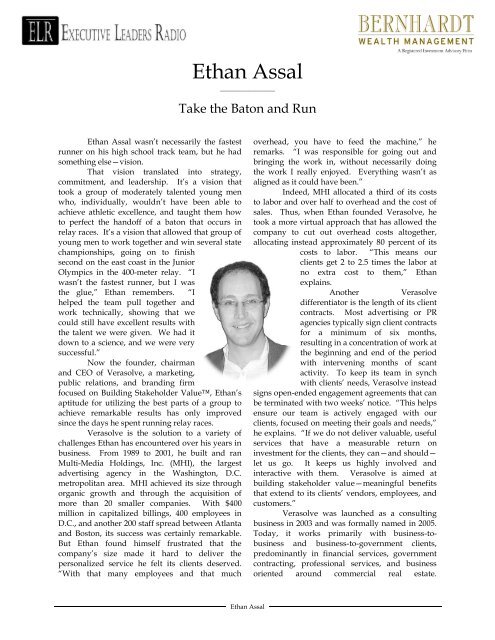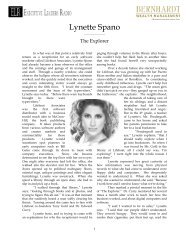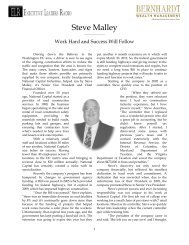Create successful ePaper yourself
Turn your PDF publications into a flip-book with our unique Google optimized e-Paper software.
<strong>Ethan</strong> <strong>Assal</strong>_________________Take the Baton and Run<strong>Ethan</strong> <strong>Assal</strong> wasn’t necessarily the fastestrunner on his high school track team, but he hadsomething else—vision.That vision translated into strategy,commitment, and leadership. It’s a vision thattook a group of moderately talented young menwho, individually, wouldn’t have been able toachieve athletic excellence, and taught them howto perfect the handoff of a baton that occurs inrelay races. It’s a vision that allowed that group ofyoung men to work together and win several statechampionships, going on to finishsecond on the east coast in the JuniorOlympics in the 400-meter relay. “Iwasn’t the fastest runner, but I wasthe glue,” <strong>Ethan</strong> remembers. “Ihelped the team pull together andwork technically, showing that wecould still have excellent results withthe talent we were given. We had itdown to a science, and we were verysuccessful.”Now the founder, chairmanand CEO of Verasolve, a marketing,public relations, and branding firmfocused on Building Stakeholder Value, <strong>Ethan</strong>’saptitude for utilizing the best parts of a group toachieve remarkable results has only improvedsince the days he spent running relay races.Verasolve is the solution to a variety ofchallenges <strong>Ethan</strong> has encountered over his years inbusiness. From 1989 to 2001, he built and ranMulti-Media Holdings, Inc. (MHI), the largestadvertising agency in the Washington, D.C.metropolitan area. MHI achieved its size throughorganic growth and through the acquisition ofmore than 20 smaller companies. With $400million in capitalized billings, 400 employees inD.C., and another 200 staff spread between Atlantaand Boston, its success was certainly remarkable.But <strong>Ethan</strong> found himself frustrated that thecompany’s size made it hard to deliver thepersonalized service he felt its clients deserved.“With that many employees and that muchoverhead, you have to feed the machine,” heremarks. “I was responsible for going out andbringing the work in, without necessarily doingthe work I really enjoyed. Everything wasn’t asaligned as it could have been.”Indeed, MHI allocated a third of its coststo labor and over half to overhead and the cost ofsales. Thus, when <strong>Ethan</strong> founded Verasolve, hetook a more virtual approach that has allowed thecompany to cut out overhead costs altogether,allocating instead approximately 80 percent of itscosts to labor. “This means ourclients get 2 to 2.5 times the labor atno extra cost to them,” <strong>Ethan</strong>explains.AnotherVerasolvedifferentiator is the length of its clientcontracts. Most advertising or PRagencies typically sign client contractsfor a minimum of six months,resulting in a concentration of work atthe beginning and end of the periodwith intervening months of scantactivity. To keep its team in synchwith clients’ needs, Verasolve insteadsigns open-ended engagement agreements that canbe terminated with two weeks’ notice. “This helpsensure our team is actively engaged with ourclients, focused on meeting their goals and needs,”he explains. “If we do not deliver valuable, usefulservices that have a measurable return oninvestment for the clients, they can—and should—let us go. It keeps us highly involved andinteractive with them. Verasolve is aimed atbuilding stakeholder value—meaningful benefitsthat extend to its clients’ vendors, employees, andcustomers.”Verasolve was launched as a consultingbusiness in 2003 and was formally named in 2005.Today, it works primarily with business-tobusinessand business-to-government clients,predominantly in financial services, governmentcontracting, professional services, and businessoriented around commercial real estate.<strong>Ethan</strong> <strong>Assal</strong>
Verasolve’s target demographic is companies thatwould benefit from having a VP of Marketing, butthat do not necessarily want the expense of havingone. While these companies tend to have morethan ten employees and less than a couplehundred, substantially larger companies have alsoutilized Verasolve’s public relations expertise.Whether clients are looking to expand brandrecognition, find more qualified prospects, orincrease closing ratios, the efforts of <strong>Ethan</strong> and histeam translate into tangible, meaningful results—more prospects and significantly higherpercentages of deals closed.<strong>Ethan</strong> began learning the science and art ofgood business as a boy. He was born in Brooklyn,New York, shortly after his mother, a teacher,returned from Israel, where she met his father. Hisfather grew up in Tunisia, but fled to Israel whenwar broke out in 1948. There, he found work as afarmer, but knew no English and had not finishedhigh school. Once he arrived in the U.S., <strong>Ethan</strong>’sfather earned his high school equivalent,eventually becoming the first person in his familyto attend college. He went on to a career as asuccessful electrical engineer. “When I was young,I remember my father studying all the time, goingthrough college while simultaneously learningEnglish,” <strong>Ethan</strong> reminisces. “This taught me at ayoung age what could be accomplished throughhard work, strong focus, and a desire to make abetter life for your family.”When the young family moved to the D.C.metropolitan area, <strong>Ethan</strong> would shovel snow fromwalkways and cut lawns to earn money. And justas he never cut corners in his work, his parentsmade sure he did not cut corners on the balancesheet either. <strong>Ethan</strong> had to purchase his ownshovels for the walkways and gas for thelawnmower, which taught him the importance ofrunning a profitable business that covered its owncosts.These early lessons in business combinedwith another defining moment in <strong>Ethan</strong>’schildhood to help chart his course along the pathof entrepreneurship. In 1972, an elementary schoolclass project assigned students a historicalpresidential candidate for whom they had toorganize a mock campaign. <strong>Ethan</strong> was assignedGeorge Wallace. “Each student received buttonsand bumper stickers from the various campaigns,and I began to collect political memorabilia—ahobby that continued for the next seven years,” heremembers.In 1977, when Jimmy Carter wasinaugurated, <strong>Ethan</strong> purchased a stock ofinauguration buttons wholesale and thenorganized a group of classmates to sell them at theevent, earning several thousand dollars. Atsubsequent inaugurations, that team grew to morethan 100 people, each of whom would keep apercentage of the revenues. <strong>Ethan</strong> would rent ahotel suite on Pennsylvania Avenue, which wasused as an operations base where he could managethe supplies and cash.<strong>Ethan</strong> graduated from high school in 1979and went on to attend college at BrandeisUniversity. In 1980, while at a politicalmemorabilia trading convention, a friendmentioned to <strong>Ethan</strong> in passing that rock and rollbuttons would be the wave of the future.“Something in my mind clicked, and I knew Iwanted to ride that wave,” he recalls.<strong>Ethan</strong> began researching the industry,learning how rock and roll buttons were made andwhere they were being sold. Using this knowledgeand leveraging his experience selling politicalbuttons, he began running a music merchandisingbusiness out of his college dorm room. Afterrunning the business from the dorms for a year,<strong>Ethan</strong> began renting a large house off campus torun sales and ordering functions. He designed thebuttons and then shipped them to a third partymanufacturer who would assemble them. Themanufacturer then sent the merchandise to <strong>Ethan</strong>’smother, who handled the distribution of thebuttons out of her garage. She hired kids whowould come over after school, sort the buttons, fillbags, and ship them.“In the midst of the venture’sdevelopment, my parents still insisted I work as abusboy at O’Donnell’s Sea Food because theythought the business wouldn’t work out,” helaughs. “I was working for six dollars an hourthere, while the business was earning five to tenthousand a month. Finally I put my foot downand said I wasn’t going to continue at therestaurant.” While his Bar Mitzvah money and astudent loan paid for his first semester of college,<strong>Ethan</strong> was able to use his button business to payfor each semester thereafter as he became thelargest distributor and manufacturer of rock androll buttons in the United States.Though his assembly workforce included anumber of autistic and handicapped workers, heProfiles in Success: Inspiration from <strong>Executive</strong> <strong>Leaders</strong> in the Washington D.C. Area
never applied for the tax credit he qualified forbecause it was too much paperwork. “It was awin-win for both the workers and their parents,”<strong>Ethan</strong> recalls. “We gave them an opportunity andwere able to help improve lives, and they providedvaluable work in return.”When he started college, <strong>Ethan</strong> wasfocused on obtaining a political science andeconomics degree with the expectation ofattending law school following his undergraduatestudies; however, he soon found himself puttinghis formal education on the backburner so hecould focus on what really drove him—running onthe track team and leading his highly successfulbusiness. By his senior year, <strong>Ethan</strong>’s rock and rollbutton company was generating $3 million inannual revenue. It was at that time that <strong>Ethan</strong>decided to move the business to his home state ofMaryland, finishing his final two classes at theUniversity of Maryland.In Maryland, at the age of 22, <strong>Ethan</strong>decided to build a warehouse for the company.He purchased some property in Gaithersburg andobtained an Industrial Revenue Bond from thestate to expand the business and build a 40,000square foot warehouse for production anddistribution. The property included an office spacefor sales and space for a printing plant andmanufacturing equipment, with the remainder ofthe space designed to be leased out to tenants.Unfortunately, in a setback during thecourse of construction, his architect and a builderwere both caught up in the savings and loanscandal and filed for bankruptcy. This promptedthe bank to pull its funding until <strong>Ethan</strong> got anoccupancy permit and the building was fullyleased.This turn of events gave <strong>Ethan</strong> theopportunity to assume the role of generalcontractor tasked with bringing the project tocompletion. Yet it proved a more complicated taskthan he imagined, as the original subcontractorssought to file mechanics liens because thebankrupted builder had not yet paid them.Though the circumstances were dire, over thecourse of six or seven months, and with a lot ofhard work, <strong>Ethan</strong> pulled it all together andcompleted construction of the building. He wasthen able to lease space to an automotive repairfirm and a company that installed a glasstempering furnace for glass work. The bank thenfunded the rest of the money, ensuring all theoriginal subcontractors were paid in full.Its early difficulties behind it, the businesshummed along until the end of 1985, when jeanjackets fell out of fashion, replaced by leatherjackets that couldn’t withstand the pinprick of abutton. Though <strong>Ethan</strong> had been shipping over amillion buttons each month, the demand suddenlydisappeared. “Being 24 years old, it wasn’t muchfun anymore, and the business wasn’t growing,”he recalls. “Someone expressed interest inpurchasing the building, and another party wasinterested in buying the inventory and assets of thebuilding, so I sold both and went into semiretirementfor a while, trading index options in myown account.”In order to track his options, <strong>Ethan</strong> boughtan early Macintosh computer. He also began usinga software package called PixelPaint, a predecessorto Photoshop. Although he had done a lot ofgraphics work in the music merchandisingbusiness, he was amazed that technology hadevolved such that he could get a color printdirectly from a computer. <strong>Ethan</strong> contacted a localdistributor who owned or had access to equipmentlike color printers, scanners, and film recordersthat would shoot a 35 mm slide from a computerfile. As the equipment sat unused 90 percent of thetime, he convinced the distributer to go intobusiness scanning files or shooting slides forclients. “It was a very early graphics servicebureau,” he recalls.From 1989 to 2001, this modest idea grewinto a company called <strong>Executive</strong> Presentations,which then evolved into two divisions, EPISystems and EPI Communications. Thesedivisions then became MHI, ranked in 2001 by theWashington Business Journal as the largestadvertising agency in D.C. Starting with workprimarily with 35 mm slides, the companyexpanded to open a photo lab, and later beganmaking large posters. It then dove into the tradeshow business, hired designers, infiltrated theevents staging industry, and made a name for itselfin advertising, marketing, video production,multimedia, and web presence. The companyraised mezzanine capital and venture capital, andcontinued to expand through acquisitions.Eventually, the sheer size of the companytook too much time away from <strong>Ethan</strong>’s personallife and allowed for less personalized attention forclients. He sold MHI in 2001 and createdVerasolve, a smaller company focused on building<strong>Ethan</strong> <strong>Assal</strong>
teams to help clients realize their unique visions.Evoking the tenets that brought him success as arelay runner on the track team, <strong>Ethan</strong> recognizedteamwork as a primary ingredient in his success.“I’m a big believer in delegating,” he affirms.“You can’t accomplish a significant number ofthings unless you delegate. I like to keep reportslow, and it’s important to have people on the teamwho are self-starters and can get things done ontheir own. Let them run with things and let themcome to you for significant decisions or when thereare situations where they need some help andmentoring.”This mentoring philosophy has played animportant role in his leadership style through theyears, and many of his employees have gone on tostart their own thriving businesses. For <strong>Ethan</strong>, thishighlights one of the most important lessons ofbusiness—that life isn’t all about business. “It’sabout community,” he says. “It’s about sharing,teaching, being on boards of differentorganizations, and helping people less fortunate.It’s about working as a team to build a network ofpositive impacts that extend long after you’regone.” <strong>Ethan</strong>, himself, sits on the boards of theMontgomery County Community Foundation andImagination Stage, a children’s theaterorganization. The combined impact of hisprofessional and philanthropic efforts has earned<strong>Ethan</strong> the Entrepreneur of the Year Award fromErnst & Young, and Washingtonian Magazine’sForty Under Forty award, among others.In advising young adults entering theworkforce today, <strong>Ethan</strong> reminds us that risk-takingis easiest when you’re young. “The opportunity isnow,” he urges. “It helps to look at your life as avalue stream, with respective rates of return. Inyour teens and 20s, if you make a mistake, you’renot giving a lot up. You’re not at the top of yourearning potential, and you don’t have a family or alot of fixed costs. This is the time you can really goout there, take some chances, make a mark foryourself, and see if you can latch onto somethingthat’s really exciting and that really takes off. Thisis the time.” Indeed, whether it’s your leg of therace, or your moment to start a newentrepreneurial journey, this is the time to take thebaton and run. By Gordon J. Bernhardt, CPA, PFS, CFP ® , AIF ®About Gordon J. BernhardtPresident and founder of Bernhardt WealthManagement and author of Profiles in Success:Inspiration from <strong>Executive</strong> <strong>Leaders</strong> in theWashington D.C. Area, Gordon provides financialplanning and wealth management services to affluentindividuals, families and business-owners throughoutthe Washington, DC area. Since establishing his firmin 1994, he and his team have been focused onproviding high-quality service and independentfinancial advice to help clients make informed decisionsabout their money. For more information, visitwww.BernhardtWealth.com and Gordon’s Blog.________________________Profiles in Success: Inspiration from <strong>Executive</strong> <strong>Leaders</strong> in the Washington D.C. Area







